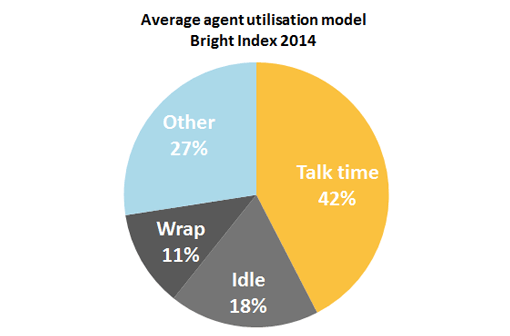Mats Rennstam takes a look at what shrinkage really means in the contact centre and how you could be managing it.

According to our UK-based benchmarking in the last 12 months, only 42% of an agent’s time is actually spent doing what we really want them to be doing – talking to customers!
This means that a massive 58% of an agent’s time is not being spent on the phone talking to customers. This is Shrinkage… the amount of time when agents are being paid to be on the phone but are not actually working or available to receive calls.

Shrinkage tells us what can be done to help manage resource levels
So what does Shrinkage tell us? From a resourcing perspective, it helps to have a good grasp on what your organisation’s shrinkage is and what levers you can pull in order to help manage your resource levels and still meet customers’ needs.
It can also be used politically to help explain your FTE and resourcing requirements to stakeholders who don’t have a day-to-day understanding of contact centres.
Just because only 42% of an agent’s paid time is spent talking to customers doesn’t mean we can sack the other 58%!
‘Other’ impacts resourcing with a huge 27% on average, but there a multitude of factors that influence this: holiday, training, meetings, absenteeism, to name but a few. If it isn’t talk-time, idle time (available time) and wrap time (ACW), then it falls into the ‘other’ segment.
The majority of the factors that feed into shrinkage can be tweaked
What is good news is that the vast majority of the factors that feed into shrinkage can be influenced and tweaked to help drive more efficiencies at the same time as considering employee engagement needs.
A metric such as wrap time can be affected by the systems and processes agents have to adhere to, but could you also consider how effectively it is managed? Are poor agent behaviours challenged? The same could be said about absenteeism: are high levels of absence just accepted as the norm? Or is there an effective absence-management policy in place?
There is a danger that operational managers will choose the ‘easier levers’
There is, however, a danger that operational managers will choose to pull the ‘easier levers’ in order to help minimise the impact of shrinkage. Cancelling meetings, training and 1-2-1’s will add extra resource for a short space of time, but what impact will this have on employee engagement if this happens on a regular basis?
Overtime will alleviate the strains of excess call demands, but a more effective resource model, fit for purpose shift patterns and effective workforce management would offer a more suitable long-term solution.

Mats Rennstam
A large number of contact centres underestimate shrinkage levels by not taking into account hidden areas of shrinkage, including lateness, talking to associates, personal calls, leaving early and longer breaks, etc. It is also fair to say that operations that use workforce management solutions effectively manage the strains of shrinkage more effectively.
Shrinkage is a major factor for contact centres not achieving the desired service level and meeting customers’ expectations. If all shrinkage factors are monitored, managed, and taken into account when forecasting and scheduling, then you can achieve higher service levels at lower operating costs.
With thanks to Mats Rennstam at Bright UK
Author: Robyn Coppell
Reviewed by: Megan Jones
Published On: 3rd Dec 2014 - Last modified: 28th Feb 2024
Read more about - Archived Content, Bright, Shrinkage







